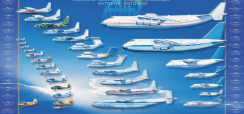Aircraft safety is achieved by appropriate aviation equipment maintenance, as well as by providing a background for efficient use of aircraft as intended. Continued airworthiness procedures for “AN” fleet of different types are developed and improved systematically at the ANTONOV Company. The experience gained from performed tests of the aircraft construction and annual analysis of each type fleet operation are taken into consideration therein. The ANTONOV Company, based on the results of static tests, the estimation of equivalent loads, and an accumulated experience in fleet operation, conducts scientific and research works on defining the opportunities and conditions for service life and service time extension individually for each “AN” aircraft type. The ANTONOV Company’s specialists on a regular basis review the effective operation and maintenance publications regarding to all “AN” aircraft types for compliance with actual operation conditions, update it to increase the level of safety and to reduce operators’ expenses on aircraft.
Continued airworthiness, make corresponding amendments and supplements in it, develop service bulletins on adjustments relevant to service life and service time limitations, and bulletins that are pertinent to “AN” aircraft safety as well. All operators have the opportunity to familiarize themselves with actual operation publications in respect of corresponding aircraft types on the ANTONOV Company’s specialized portal. The ANTONOV Company’s specialists are engaged in activities related to continued airworthiness and life time of “AN” aircraft, by virtue of research works on defining the opportunities and conditions for their extension, for each specific aircraft due to its technical peculiarities and operating time since placed in service and since last overhaul, as well as in view of changes made in design. All decisions concerning the aircraft major zones, replacement of parts or units, or design modifications are subject to rigorous analysis, testing, verification, and certification. With the knowledge of critical zones and through the use of inspection equipment, it will enable to detect opportunely dangerous hidden defects and to give recommendations on their elimination and the high-quality repair.




